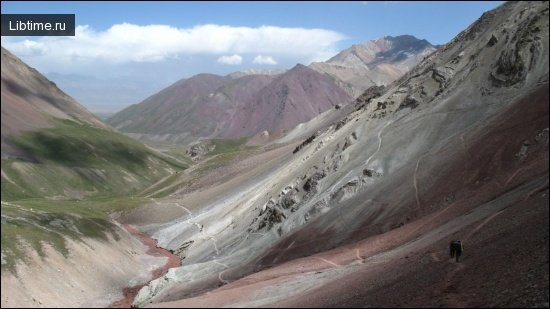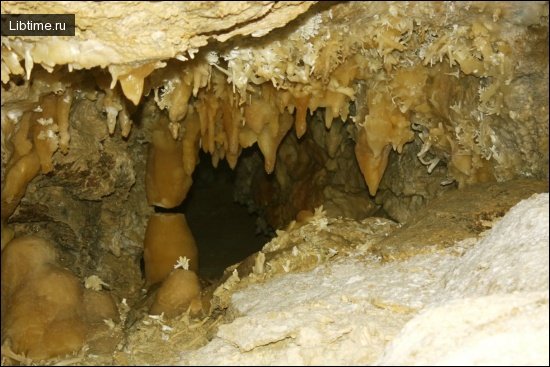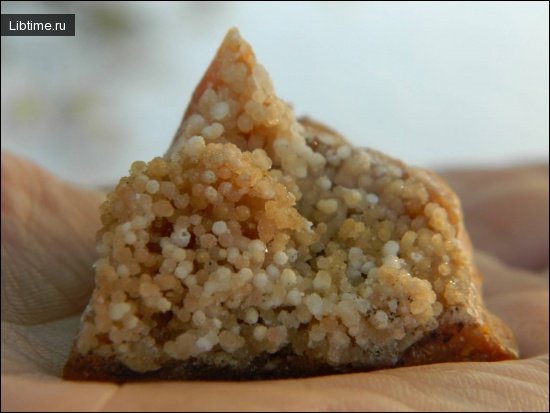Stalactites. Types of stalactites
Cave stalactites have always been of interest to people. Among the nalectic stalactite formations there are gravitational (thin-tubular, cone-shaped, lamellar, curtain-shaped, etc.) and anomalous (mainly helictites).
Thin-tubular stalactites
Especially interesting are thin-tube stalactites, which sometimes form entire calcite thickets. 
This leads to the release of colloidal calcium carbonate from the saturated solution, which is deposited along the perimeter of the drop falling from the ceiling in the form of a thin roll. Gradually building up, the rolls turn into a cylinder, forming thin-tubular, often transparent stalactites.
The inner diameter of tubular stalactites is 3-4 mm, the wall thickness usually does not exceed 1-2 mm. In some cases they reach 2-3 and even 4.5 meters in length.
Cone-shaped stalactites
Among the stalactites , cone-shaped stalactites are the most common ones 
The sizes of cone-shaped stalactites, located mainly along the cracks and well indicating them, are determined by the conditions of calcium carbonate intake and the size of the underground cavity.
Usually stalactites do not exceed 0.1-0.5 m in length and 0.05 m in diameter. Sometimes they can reach 2-3, even 10 m in length (Novoafon cave) and 0.5 m in diameter. Interesting are spherical (bulbous) stalactites formed as a result of blockage of the tube opening.
Aberrational thickenings and patterned growths appear on the surface of the stalactite. Spherical stalactites are often hollow due to secondary dissolution of calcium by the water entering the cave.
Anemolites are curved stalactites
In some caves, where there is significant air movement, there are curved stalactites - anemolites, the axis of which is deviated from the vertical. 
If the direction of air movement periodically changes, zigzag anemolites are formed. Similar origin with stalactites are curtains and draperies hanging from the ceiling of caves.
They are associated with infiltration water seeping along a long fissure. Some curtains, consisting of pure crystalline calcite, are completely transparent. In their lower parts there are often stalactites with thin tubes with water droplets hanging from their ends.
Calcite deposits may look like petrified waterfalls. One of such waterfalls was noted in the grotto of the Novoafon (Anakopi) cave in Tbilisi. It is about 20 m high and 15 m wide.
Helictites
Helictites are complexly constructed eccentric stalactites that are part of the subgroup of anomalous stalactite formations. They occur in various parts of karst caves (on the ceiling, walls, curtains, stalactites) and have the most diverse, often fantastic shape: in the form of a curved needle, complex spiral, twisted ellipse, circle, triangle, etc.
Needle-shaped helictites reach 30 mm in length and 2- 3 mm in diameter. They represent a single crystal, which as a result of uneven growth changes orientation in space. There are also polycrystals, grown one into another.
In the section of needle-shaped helictites, growing mainly on the walls and ceiling of caves, the central cavity is not traceable. They are colorless or transparent and their end is pointed. Spiral-shaped helictites develop mainly on stalactites, especially thin-tubular ones.
They are composed of many crystals. A thin capillary is found inside these helictites, through which the solution reaches the outer edge of the aggregate. Water droplets formed at the ends of the helictites, unlike tubular and conical stalactites, do not come off for a long time (many hours).
This determines extremely slow growth of helictites. Most of them belong to the type of complex formations with intricate shapes. 
Water entering inside the stalactite penetrates into cracks between crystals and comes to the surface. This is how helictites begin to grow, due to the predominance of capillary and crystallization forces over gravity.
Capillarity is apparently the main factor in the formation of complex and spiral-shaped helictites, the direction of growth of which initially depends largely on the direction of intercrystalline cracks. 
Air with relative humidity of 90-95%, oversaturated with tiny water droplets with calcium bicarbonate, turns out to be an aerosol. Water droplets falling on the ledges of walls and calcite formations quickly evaporate and calcium carbonate precipitates.
The highest rate of calcite crystal growth is along the main axis, causing the formation of needle-shaped helictites. Consequently, under conditions where the dispersion medium is a substance in the gaseous state, helictites can grow due to diffusion of dissolved matter from the surrounding aerosol.
Helictites created in this way ("aerosol effect") have been called "cave frost". 
These positions, however, are insufficiently argued and, as studies of recent years have shown, are largely debatable.
Thus, morphological and crystallographic features of eccentric natellite forms can be explained either by capillarity or aerosol influence, as well as by a combination of these two factors.
Interesting articles: Stalagmites, Structure of stalactites


